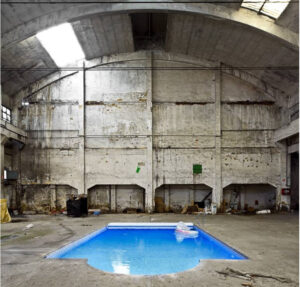Verner Panton, a Danish designer known for his bold, futuristic, and immersive environments, remains one of the most influential figures in mid-20th century design. His work was characterized by an experimental approach to color, form, and material, pushing the boundaries of traditional interior spaces and transforming them into surreal, otherworldly experiences.
Though not directly associated with cult rooms or ritualistic spaces, Panton’s work often evoked a dreamlike, almost hallucinogenic atmosphere. His swimming pool environments, light installations, and modular seating designs created experiences that blurred the lines between architecture, art, and sensory perception.
Born in 1926 in Denmark, Verner Panton studied at the Royal Danish Academy of Fine Arts in Copenhagen, where he initially trained as an architect. However, his true passion lay in challenging conventional design norms. He worked under Arne Jacobsen, one of Scandinavia’s most famous modernist architects, before branching out to develop his own unique style.
By the late 1950s and 1960s, Panton had fully embraced an avant-garde approach—one that rejected minimalism and instead celebrated fluid forms, vibrant colors, and synthetic materials. His work was often seen as radical and unconventional, yet it quickly became emblematic of the era’s fascination with space-age aesthetics and psychedelic culture.
The Psychedelic Swimming Pool: A Study in Light and Space
One of Panton’s most famous and experimental works was his design for an immersive swimming pool environment. Unlike conventional pools, which prioritize function over form, Panton’s creation was a multi-sensory experience where light, water, and space interacted in a surreal and hypnotic manner.
This space was not simply a recreational pool—it was a controlled environment that played with depth perception, reflection, and fluid movement. The entire design centered on atmospheric lighting effects, which transformed the water into a shifting canvas of color and motion.
Key Features of Panton’s Swimming Pool Design:
• Psychedelic lighting effects that changed based on movement and reflections.
• Curved, organic architecture that eliminated hard lines and traditional geometric structures.
• Bold, saturated color palettes that enhanced the feeling of stepping into another dimension.
• Water as an interactive element, influencing both the physical experience and visual perception of space.
Why Was This Project So Groundbreaking?
At the time, the 1960s and 1970s saw an explosion of interest in altered states of perception, influenced by the rise of psychedelic culture, space exploration, and experimental art movements. Panton’s pool project captured this cultural moment perfectly, creating an environment that stimulated the senses and altered reality without the need for external substances.
This project wasn’t just about aesthetics—it was about how space could influence the human experience. The shifting lights and fluid architecture could evoke a meditative or even transcendental state, making it a precursor to modern immersive art installations like those created by James Turrell or TeamLab.
Total Environments & Psychedelic Interiors
Panton wasn’t just interested in designing furniture or architecture—he aimed to create total environments that enveloped the occupant in a complete sensory experience. Some of his most famous works include:
The Visiona Series (1968-1970)
• Created for the Visiona exhibitions at the Cologne Furniture Fair, these environments featured curved, modular seating, vibrant lighting, and fully immersive color schemes.
• The Visiona 2 installation (1970) was particularly notable for its psychedelic aesthetic, turning a simple space into a surreal dreamscape of undulating forms and electric hues.
Panton’s Famous Room Designs
• The Varna Restaurant (1971): A futuristic dining space with intense red lighting, layered ceilings, and soft, organic furniture.
• The Spiegel Publishing Headquarters (1969): One of the most futuristic office interiors of its time, using bright colors, curving structures, and modular designs.
The Living Tower (1969)
• A modular, multi-level seating structure that encouraged dynamic interaction with space. This design blurred the line between furniture and architecture, a signature of Panton’s approach.
Panton’s Influence on Film, Pop Culture, and Cult Aesthetics
Cinema & Psychedelic Set Design
Though Panton didn’t directly design cult film sets, his work heavily influenced the visual language of 1960s and 1970s science fiction, surrealism, and experimental cinema. Many of his organic, immersive spaces bear a resemblance to famous set designs, including:
• Stanley Kubrick’s 2001: A Space Odyssey (1968) – The clean, futuristic interiors with curved white walls and neon lighting echo Panton’s Visiona rooms.
• Ken Russell’s The Devils (1971) – The stark, highly geometric set designs resemble Panton’s bold use of color and contrast.
• Alejandro Jodorowsky’s The Holy Mountain (1973) – The psychedelic, immersive nature of Jodorowsky’s work parallels Panton’s all-encompassing design philosophy.
Modern Influences: The Rise of Immersive Art Spaces
Today, Panton’s legacy can be seen in the rise of experiential art installations and immersive environments such as:
• TeamLab’s interactive light exhibitions
• Meow Wolf’s surreal art spaces
• The rise of VR-based interior experiences
His philosophy of creating “total environments” has influenced everything from high-end retail spaces to modern nightclub designs and themed environments.
Panton’s Lasting Legacy: More Than Just a Designer
How Panton Changed the Way We Experience Space
Unlike many designers of his era, Panton was not confined to a single discipline—he worked across architecture, interior design, furniture, and lighting, ensuring that every element of his work contributed to a larger, unified vision.
His designs pushed boundaries, offering a vision of the future that was both optimistic and surreal. He showed that design isn’t just about function—it’s about emotion, perception, and experience.
Why His Work Remains Relevant Today
Even decades after his most famous projects, Panton’s bold use of color, immersive design philosophy, and rejection of traditional forms continue to inspire:
• Contemporary interior designers looking to create engaging, fluid spaces.
• Filmmakers and set designers aiming to construct surreal or futuristic aesthetics.
• Artists exploring immersive, sensory-driven installations.
Panton’s work redefined the way people engage with interior spaces, making design an experience rather than just an aesthetic choice.
Impression
Verner Panton’s work was more than just “groovy interiors” or colorful furniture—it was a rethinking of how space should feel, move, and interact with people. His swimming pool project and immersive rooms showed that design could alter perception and create a heightened sense of reality.
Though he wasn’t directly connected to cult rooms or esoteric spaces, his atmospheric, surreal interiors certainly influenced and inspired the aesthetics of cinematic and cultural movements that embraced psychedelic and immersive design.
Today, as we see a resurgence of experiential environments, from virtual reality spaces to interactive art installations, Verner Panton’s influence is more relevant than ever. His bold vision of design as an emotional, immersive experience continues to shape how we think about space, light, and human interaction—proving that he was, indeed, a designer far ahead of his time.
No comments yet.








